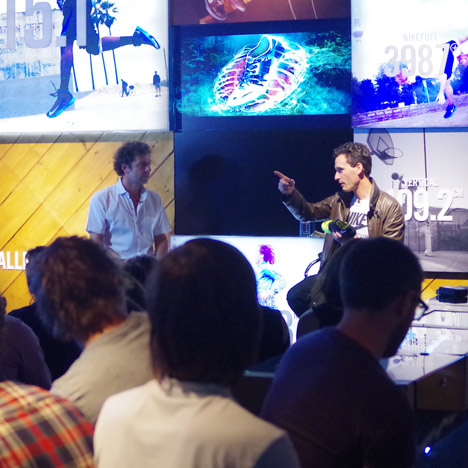Psychology is on an equal footing with technological advances when designing sportswear to improve an athlete's performance, Nike's creative director for the Olympics Martin Lotti told the audience at a talk hosted by Dezeen editor-in-chief Marcus Fairs at the Nike+ House of Innovation at Selfridges last night.
"It's not just about lightweight," he said. "It's about looking good as well as the psychological element. We see performance on all levels: environmental performance, psychological performance, physical performance."
When Nike created a custom-designed, super lightweight pair of gold shoes for Michael Johnson at the 1996 Olympics in Atlanta, the American sprinter still raced wearing a necklace that weighed more than the shoe. "You can tell that psychologically it's absolutely critical for an athlete to have this with him: it brings him good luck. So you have to bring all the elements together," said Lotti. "Yes we're trying to shave off weight or milliseconds but there're other components that as a designer you have to take into account."
For the London 2012 Olympics, the Nike team developed the Nike Pro TurboSpeed speed suit (above) that moves through the air faster than bare skin. The first speed suit they designed (for Australian sprinter Cathy Freeman at the Sydney Olympics in 2000) included a hood, but this summer Allyson Felix runs sporting a ponytail that can't be as aerodynamic.
Isn't this a step backwards? "Skin is slow, so the more you cover and the more dynamic you are the better," Lotti reasoned, but "there's a limit to it in regards to what an athlete wants to do, in regards to how much they want to cover as well as ultimately this psychological element to it."
Underlining the significance of style for results, Lotti reported that Alpine skier Maria Kirkova once told him "I perform better if I look better."
The psychology of superstitions and wanting to look good isn't just a consideration to weigh against technological advances from the lab: these insights from athletes as to what gives them a mental boost can be incorporated in new designs to actively improve performance.
For this reason, the inside surfaces of the arms and legs on the Nike Pro TurboSpeed suit feature patches of contrasting colour. "There's a psychological element to this,"said Lotti. "Now we can't quantify it - how much faster it is - but they feel faster." The colour blocking also creates a flickering effect when seen from a distance or on TV, so spectators feel that sense of speed too. "When we're designing this product we're looking at all elements: delivering upon the needs of the athletes, first and foremost, upon the environment but then even on the viewers looking on TV."
The new Nike Zoom Superfly R4 running spikes (above) are golden on the bottom for the same reason: "When you're in the stadium you actually see the flicker of the gold when the light hits it". The psychological effect on the athlete comes in here too: "Each athlete's trained for the gold."
So would Nike include a design detail if it maximised the psychological boost to an athlete but was detrimental to technological advancement? "That would be performance too. We see performance on all levels - environmental performance, psychological performance, physical performance - so you just have to weigh each of these. Like any design there are trade-offs, but I think first and foremost for us is to help the athletes to fulfil their own potential."
Watch Martin Lotti talk about more of Nike's innovations for the London 2012 Olympics in our series of movies for Nike, which we've been publishing all this week.
Watch the movies »
See more stories about Nike on Dezeen »
See more design for sports on Dezeen »

